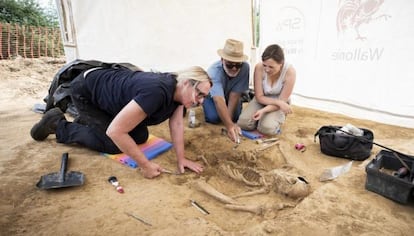It is estimated that 20,000 soldiers lost their lives at the Battle of Waterloo on June 18, 1815 in one of the harshest armed confrontations known to mankind.
The Napoleonic Empire ended that day, crushed by the allied troops commanded by the Duke of Wellington, but the remains of those who fought for and against him remained on the ground, covered by layers of earth and time.
Now, a British archaeological investigation has managed to find new bones more than two centuries after the combat.
With a name necessarily linked to history, Waterloo is a town that is located about 20 kilometers south of Brussels, in Belgium.
The newly announced discovery of the bones took place last week around the Mont-Saint-Jean farm, where Wellington had set up the main Allied field hospital.
"We have what looks like a complete human skeleton and, next to it, there is another amputated leg," Tony Pollard, a professor at the University of Glasgow and one of the mission directors, told Agence France-Presse.
The finding, which they describe as "incredibly rare", appears surrounded by medical instruments, ammunition boxes and the remains of horses, which may indicate the tragic emergency situation in which the hospital was found.
Excavation of the skeleton found in Waterloo.Chris Van Houts (Waterloo Uncovered)
“On Napoleonic battlefields, this type of very old depot is very rare.
We have been working here since 2015 and this is the first time that we have found a large pit of these characteristics”, said the archaeologist.
Only one complete skeleton had been found on the battlefield, during the construction of a museum.
According to research published by Pollard himself in the
Journal of Conflict Archeology
, it is very likely that this scarcity of bones is due to the fact that they were once sold as fertilizer.
Shortly after the end of the battle, the curious and looters would have already begun to roam the area, trying to make some kind of profit, according to the journalistic chronicles of the time, in search of clothing, personal objects and even dental prostheses. those fallen in combat.
According to this hypothesis, the abundant bone material would have been turned into flour for composting.
Although the uncertainty about what really happened is still great.
However, discoveries in the area have trickled down through the years.
The excavation project, which includes archaeologists, students, military personnel and veterans, was launched in 2015 to mark the bicentennial of the battle.
In 2019, the remains of three amputated legs were discovered at the site.
The excavation was then halted due to the coronavirus pandemic.
Eva Collignon, a Belgian archaeologist, has pointed out that the latest bones discovered were probably collected "in a hurry" in a ditch near the field hospital because the number of victims was so high.

